Imagine a tiny code so powerful it shapes who you are – from the color of your eyes to your love for spicy food. This isn’t science fiction; it’s DNA, the amazing molecule at the core of life itself!
DNA, or deoxyribonucleic acid, is a long, spiraling molecule found in every cell of your body. Think of it as a twisted ladder or a zipper that holds the instructions for building and maintaining an organism. This incredible molecule contains genes, which act like individual recipes for various traits and functions in our bodies.
DNA is the instruction manual for building an organism. It tells cells how to grow, function, and reproduce. These instructions are grouped into segments called genes. For instance, some genes decide your hair color, while others may influence how you digest food. What's fascinating is that tiny variations in this DNA code make each of us unique, contributing to our individual traits and even certain health predispositions.
DNA is not just about the present. It's a record of our evolutionary past. By studying it, scientists have traced human lineages back thousands of years and unlocked secrets of our survival and diversity. Looking ahead, it could be the key to groundbreaking medical treatments and understanding life at its most fundamental level.
Did you know that if you stretched out the DNA in one cell all the way, it would be about two meters long? That's around six feet – as tall as a doorway! Yet, it’s so tiny that it fits snugly into a space smaller than a pinpoint. Also, humans share about 99% of their DNA with chimpanzees and, surprisingly, about 50% with bananas!
Remember, DNA isn’t just biology – it’s the story of life, and you’re a unique chapter in this vast, unfolding book. Stay tuned for more from our "5-Minute Genetics" series, where we’ll unravel more genetic mysteries!
A cleft chin, more famously known as a “butt chin,” is characterized by a dimple or crease in front of the chin. While it is a seemingly harmless trait, it can become pesky at times. From being a tough shaving spot to its increasingly prominent display on your portrait, it can cause minor inconveniences. But did you know that in some places, a cleft chin is considered a beauty trait? Whether you have chosen to embrace it or trying ways to get rid of it, understanding the genetics and inheritance of cleft chin can come in handy.
Did You Know?
The DNA data from your genetic ancestry test can be used to learn important things about your health, from your risk for heart disease and stroke to food intolerances and sleep disorders. You can upload your DNA data to learn 1,500+ things about your health. Learn more.
A chin with a Y-shaped dimple in the middle is a cleft chin. It is a genetic trait.
People with less facial fat will have a more noticeable cleft or dimple on the chin. Cleft chin has had cultural significance in some communities around the world.
In ancient China, a cleft chin was associated with royalty.
This feature is most noticeable when the mouth is closed and the jaw is at rest.
The appearance of a cleft chin can vary in depth and size among different individuals.
Having a cleft chin is a normal variation in human anatomy and is neither a health concern nor a sign of any underlying medical condition.
It's simply a trait that can be inherited, much like eye color or hair type.
Cleft chins are a result of an unfused jawbone.
The shape of your chin is determined even before you are born.
As the fetus develops, the mandible or the jawbone grows from both sides of the head and meets in the middle of the chin.
In some people, the bones don’t fuse, leaving a small gap or cleft.
The skin over the tiny gap is indented, creating the dimple.
A cleft chin is the same as a chin dimple.
It is also colloquially referred to as “butt chin.”
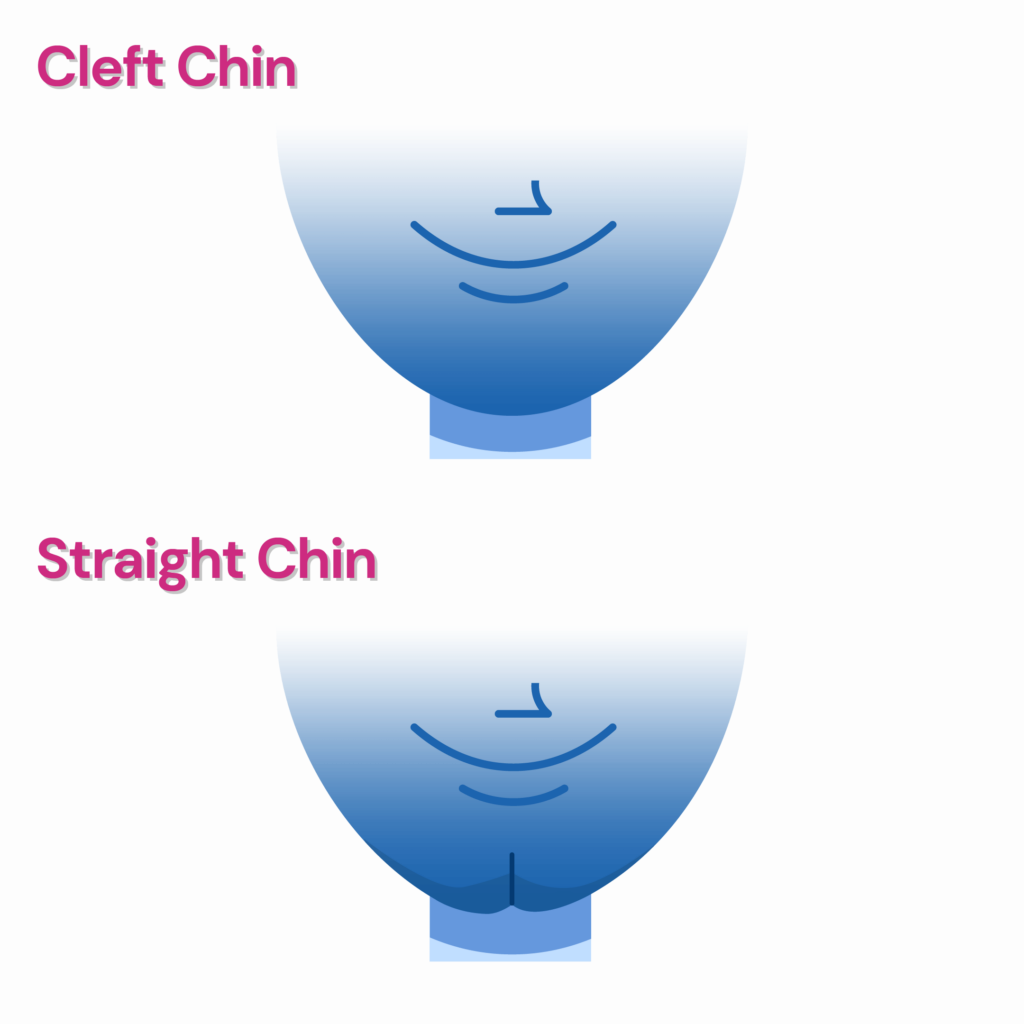
Like our other facial features like eye color, nose shape, etc., a cleft chin is also a strong trait of genetics.
A cleft chin is caused due to mainly two reasons:
A cleft chin is inherited as a dominant trait.
You will receive two copies of a gene at birth from either of your parents.
If one copy is that of a cleft chin, you will likely have one.
However, you might sometimes have a cleft chin even though neither of your parents has it.
A cleft chin is a dominant trait.
A dominant trait means that if you have one copy of the cleft chin gene from one parent, you will likely have a cleft chin.
However, this theory is contested.
Sometimes, you can have a cleft chin even though neither of your parents has it.
This phenomenon is called “genetic penetrance,” a common genetic trait where genes skip a few generations before they appear again.
Since it is a dominant condition, theoretically, even if one biological parent has a cleft chin, there’s a 50% chance that you will also have it.
Genes that control tongue development also control chin development.
Tongue and jaw genes are also linked to the roof of your mouth and have a role in cleft palates and lips.
The genetic marker for cleft chin is located in chromosome 2, called rs11684042.
Cleft chins can appear differently in males and females due to hormonal influences and differences in bone structure. Generally, it might be more pronounced in males.
While genetics play a crucial role in the development of a cleft chin, environmental factors during fetal development can also influence its appearance.
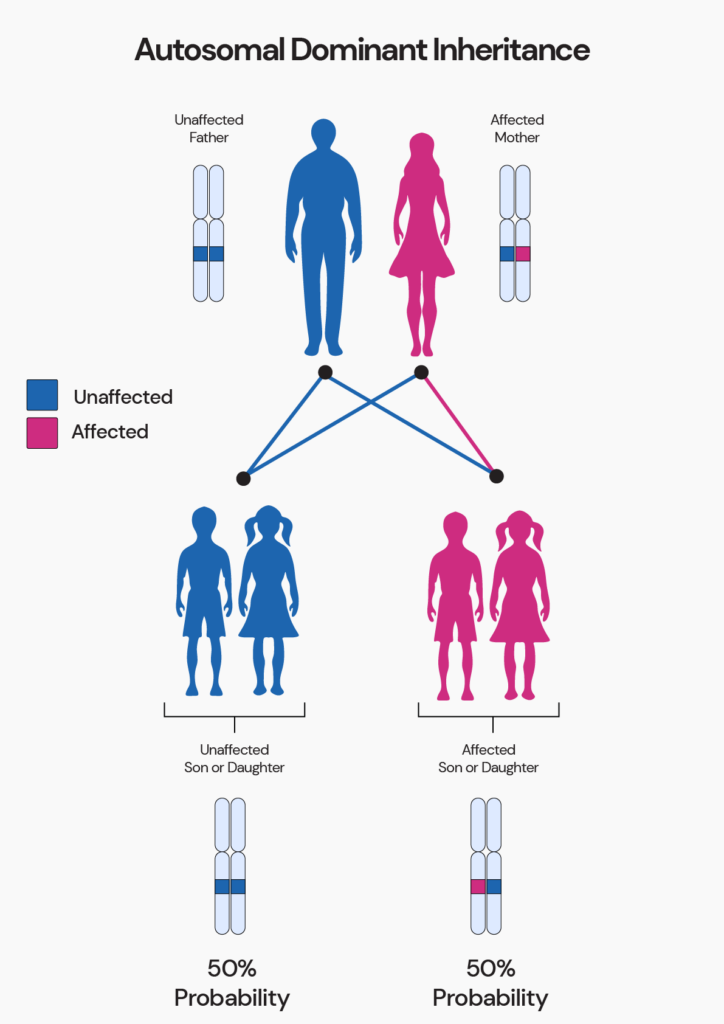
Cleft chin is not something that one can "develop" as they age.
Therefore, a genetic test to understand the likelihood of developing a cleft chin would be pointless.
However, if you are curious about this trait, companies like 23andMe offer a test where they analyze 38 variants for cleft chin.
Even if you do not have a cleft chin, you may contain variants associated with them, which may express themselves in future generations through the previously seen concept called penetration.
A cleft chin genetic test could be a fun way to understand your "hidden traits."
The cleft chin is a Y-shaped dimple on the chin.
It usually happens when the two parts of the jaw bone do not fuse properly, which creates a gap or cleft.
Like many other traits, such as eye color or height, cleft chin also has a genetic basis.
It is hereditary, which means you are likely to have it if your parents have it.
No specific tests identify a gene associated with a cleft chin.
https://udel.edu/~mcdonald/mythcleftchin.html
https://www.healthline.com/health/cleft-chin
https://www.ncbi.nlm.nih.gov/pmc/articles/PMC3351211/
https://www.mdpi.com/1422-0067/23/2/953
Assisted fertility programs are on the rise globally, and more couples face fertility challenges in their journey to get pregnant. Male infertility is, unfortunately, not as well explored as female infertility. Recent studies suggest that the excess use of smartphones could be one reason behind lowered male fertility rates in the last decade. Researchers believe that electromagnetic radiation from smartphones could affect sperm quality. Also, the more time spent with smartphones, the more severe the effects are. Do read to know how to mitigate this risk and be a ‘smart’ smartphone user.
Smartphones have taken over the world by storm.
Did you know that there are more phones in the world than humans?
Smartphones have made the lives of people easy and hassle-free all around the world.
However, the physiological and psychological effects of being around smartphones all the time are a constant cause for concern for healthcare experts worldwide.
Cell phones emit low levels of radio frequency (RF) signals, and the International Agency for Research on Cancer (IARC) has classified RF signals as possible carcinogens (agents that cause cancer).
Infertility is the inability of a couple to conceive a child naturally after one year or more of having unprotected sex.
Both males and females go through infertility challenges.
According to the US Department of Health and Human Services, 9% of American males have fertility issues, and in one-third of all couples who seek help, male infertility is the cause.
Poor semen quality remains the most common cause of male infertility issues.
The following are some of the reasons for poor semen quality.
Studies suggest that increased use of smartphones may have affected male fertility rates in the last decade.
Experts believe constant exposure to the electromagnetic radiation emitted by phones may affect the male reproductive system by increasing scrotal temperature and oxidative stress.
These, as a result, lead to poor sperm quality and fertility issues.
Hand-picked Content For You: Is Male Fertility Linked To Autoimmune Disorders?
A 2023 study published in the Journal of Fertility and Sterility analyzed the relationship between mobile phone usage and semen quality in young men.
A nationwide cross-sectional study was conducted between 2005 and 2018 to analyze the effect of cell phone usage on male fertility levels.
The study was conducted in six andrology laboratories close to military recruitment centers where the researchers identified participants.
In Switzerland, all men aged 18 to 22 must attend a compulsory military camp to study their fitness to serve the country.
A total of 2886 such young Swiss men were recruited for the study, and the researchers collected their biological samples.
The participants also filled out a questionnaire that asked them questions about their cellphone usage.
According to the study, men who used their phones more than 20 times daily had the lowest sperm concentration (SC) and total sperm count (TSC).
The median values of SC and TSC in men who used their phones >20 times/day were 44.5 Mio/mL and 120 Mio, respectively.
In comparison, the median values of SC and TSC in men who used their phones <5 times/day were 56.5 Mio/mL and 153.7 Mio.
The study reports that men who use their phones >20 times/day have a 30% and a 21% increased risk of having low SC and TSC values, compared to WHO reference values.
The study's primary limitation is that mobile phone usage was measured using self-reported questionnaires.
Hence, the study's accuracy depends on assuming the participants answered truthfully.
Also, the study didn’t include how the participants used their phones (texting, calling, browsing).
The amount of RF energy emitted by a phone depends on its model, generation, the quality of the network, the proximity to the nearest base station, and the use of earphones, among others. This study did not delve into these details.
The researchers conducted the study in three timeframes - 2005 to 2007, 2008 to 2011, and 2012 to 2018. Cellphone technologies have changed drastically in these periods; however, this wasn’t considered in the study.
Low male fertility decreases the chance of couples conceiving a child naturally.
Psychologically, reduced male fertility may cause lower self-esteem, increased anxiety and stress, and increased somatic symptoms (excess focus on specific physical symptoms).
In today’s world, staying away from smartphones may not be a practical solution.
Hence, the following steps may help mitigate the impact of cellphone radiation on male fertility.
You May Be Interested In: Y Chromosome Sequenced: A Pioneering Leap in Human Genetic Research
https://www.fertstert.org/article/S0015-0282(23)01875-7/fulltext
https://academic.oup.com/biolreprod/article/101/5/872/5551192
https://www.ncbi.nlm.nih.gov/pmc/articles/PMC7727890/
https://www.nichd.nih.gov/health/topics/infertility/conditioninfo/common
https://www.ncbi.nlm.nih.gov/pmc/articles/PMC4424520/
https://www.cdc.gov/reproductivehealth/infertility/index.htm#
https://rbej.biomedcentral.com/articles/10.1186/s12958-015-0032-1
https://opa.hhs.gov/reproductive-health/understanding-fertility-basics
https://www.fda.gov/radiation-emitting-products/cell-phones/do-cell-phones-pose-health-hazard#:
https://www.cdc.gov/nceh/radiation/cell_phones._faq.html#
https://pubmed.ncbi.nlm.nih.gov/2331455
From a decade ago, when it cost a billion dollars to sequence the entire DNA content, to now getting it sequenced for a thousand dollars, genomic research has come a long way. And we’re not very far from having a smartphone app that’ll warn you of your health risks, suggest medications best suited for you, and even predict the health status of your unborn baby. This is all thanks to one thing: genomics! In this article, we explore how the field of medicine and healthcare has leveraged genomic information to offer effective and personalized solutions to a range of health conditions, from diabetes to cancer. We further touch upon the future of genomic medicine as a tool to revolutionize the healthcare system.
Did You Know?
Genomic medicine is not just employed in clinical settings but is now accessible to consumers so that they can learn in-depth about how their genes interact with health. For those who have already taken an ancestry genetic test, this information can easily be accessed in just 3 steps!
Our DNA is 3 billion letters long - 4 letters, A, T, G, and C, are repeated across the entire length. Sequencing is a technology that allows scientists to decipher the order in which the 4 letters are arranged.
Depending on the application, the entire 3 billion letters may be sequenced (whole genome sequencing), only the part of the DNA that makes protein may be sequenced (exome sequencing), or one particular gene may be sequenced (targetted sequencing).
Using the information from sequencing to improve clinical care and health outcomes through effective diagnosis and personalized treatment is known as genomic medicine.
Genomic medicine is already making huge impacts in many fields of medicine, including:
All human beings are 99.9 percent identical in their genetic makeup.
Differences across individuals in the remaining ~0.1% hold significant clues about their health. Some differences may be harmless, while some others may contribute to disease risk.
With genomic medicine, it is possible to analyze these differences in clinical settings and compare them to many reference sequences.
This information can help understand whether the differences contribute to a disease and determine the best treatment option.
| Term | Description |
| Biomarker | DNA or RNA nucleotides or bases are read in groups of three (e.g., ATG, AUG) called codons. Start and stop codons show when a protein sequence starts or ends. |
| Codon | DNA or RNA nucleotides or bases are read in groups of three (e.g., ATG, AUG), which are called codons. Start and stop codons show when a protein sequence starts or ends. |
| DNA | Deoxyribonucleic acid (DNA) is the carrier of genetic information. DNA consists of four nucleotides or bases (A, T, G, and C). DNA can replicate or make copies of itself. |
| Exome | The approximately 1% of the genome formed only by exons. |
| Exon | The protein-coding sequence of DNA (the part of the genome that is expressed). |
| Gene | A gene is a specified sequence of DNA that serves as the basic unit of heredity. “Gene” comes from the Greek word genea, meaning generation. |
| Gene expression | When a gene is turned on, and its RNA or protein product is being made, the gene is said to be expressed. The on/off state of cells is called a gene expression profile, with each cell type having a unique profile. |
| Genome | The genome includes all of an organism’s DNA, including both exons and introns. |
| Germline | Germline cells are sperm, egg, or embryo cells. Changes to the germline are permanent. Germline traits or mutations are inherited and generational. |
| Intron | The non-protein coding sequence of DNA (the part of the genome that is not expressed). |
| MicroRNA | MicroRNA (miRNA) is a type of genetic material that regulates gene expression. miRNAs are promising biomarkers and can point toward the development of new therapeutic approaches. |
| RNA | Ribonucleic acid (RNA) is a single-stranded copy of the DNA sequence that plays a messenger role in helping cells carry out instructions for making a protein. RNA consists of four nucleotides or bases (A, U, G, and C). The DNA T is replaced by the RNA U when copied. |
| SNP | A single-nucleotide polymorphism (SNP, pronounced “snip”) is a DNA sequence variation that occurs when a single nucleotide (A, T, C, or G) in a gene sequence is altered. SNPs are the most abundant variant in the human genome and are the most common source of genetic variation, with more than 10 million SNPs present in the human genome. They can also serve as biomarkers. |
| Somatic | Somatic cells include stem cells, blood cells, and other cell types. Changes to somatic cells are not permanent, meaning they cannot be passed down by generation. Somatic cell mutations include acquired alterations that can result from chemical or radiation exposure. Changes may also occur as cells are copied during growth or repair processes. |
Despite being a relatively new field, genomic medicine has impacted diagnostics and treatment in a significant manner.
It’s also been serving as a decision-making tool for many healthcare professionals.
But it’s important to know that despite the abundance of information our genome can provide us, our ability to understand it is still developing.
The more and more we learn about it, the more impact it will have on healthcare.
Genome sequencing is currently employed in a few healthcare fields, like cancer stratification, precision medicine, diagnosis and characterization of genetic diseases, and drug development.
In recent years, scientists worldwide have been trying to identify genetic changes associated with several types of cancer to determine their role in tumor development and metastasis.
There has also been an ongoing attempt to use these findings to fight cancer.
Genomic medicine can help understand three important aspects of cancer.
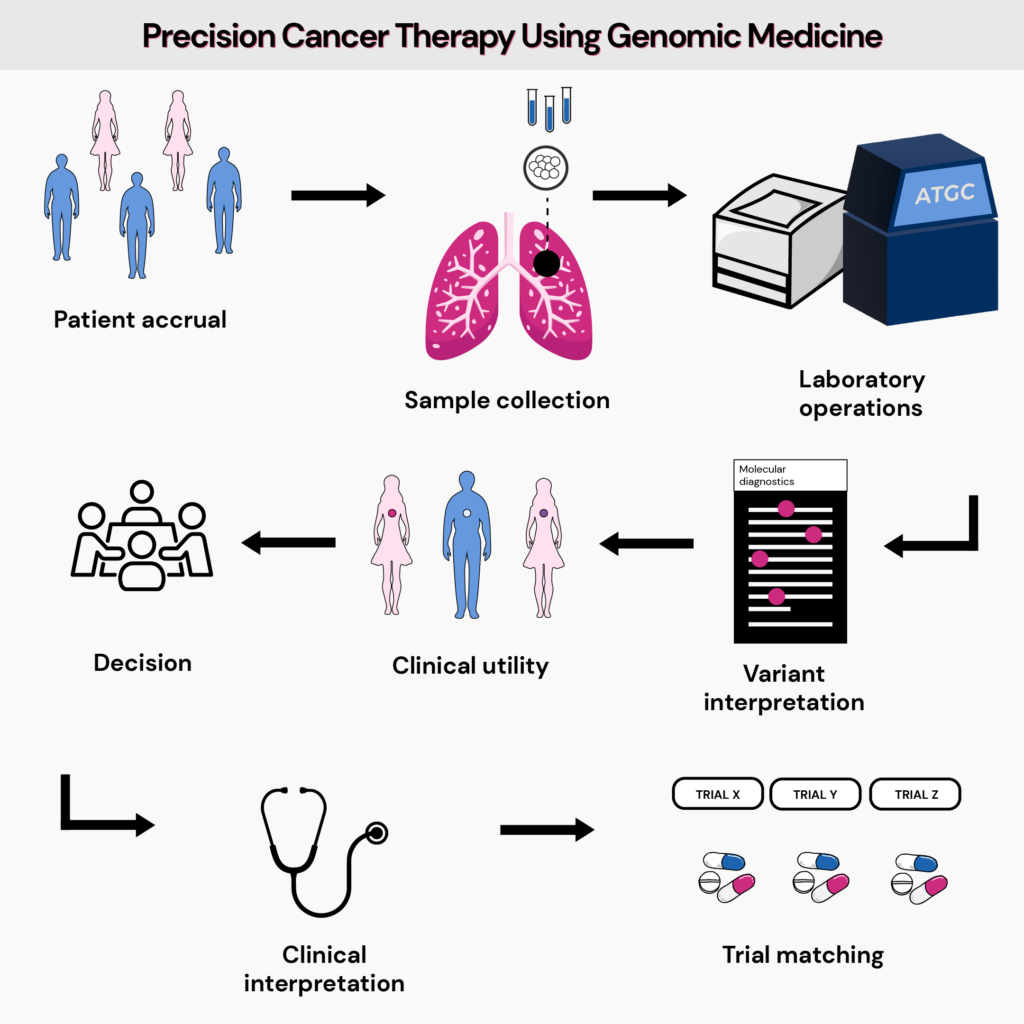
Precision medicine is cancer, most often means looking at how changes in certain genes in a person's cancer cells might affect their care, such as diagnosis, treatment, and other management options.
It has allowed clinicians to classify tumors based on mutations and responses to drug therapies.
This allows drug development that can fight cancer in more than one way.
Such targeted therapies also help overcome the severe side effects of chemotherapy to an extent.
Since the treatment can be designed to target certain characteristics present only in cancer cells and not normal cells, they are less toxic to the patients.
The following are some examples of drugs developed using precision medicine:
Using genomic information to analyze how a person’s genes affect their response to medication is called pharmacogenomics.
Before the advent of pharmacogenomics, drug development followed the “one-size-fits-all” approach.
Genomic medicine has now challenged this idea by bringing into light the different ways a person’s genetic makeup can affect drug responses.
Pharmacogenomics allows your doctor to identify the drugs that’ll likely work for you and the optimal dosage.
This applies to various classes of drugs, including antidepressants, opioid pain relievers, heart medications, anti-inflammatories, anti-diabetics, and medications used before and after surgery.
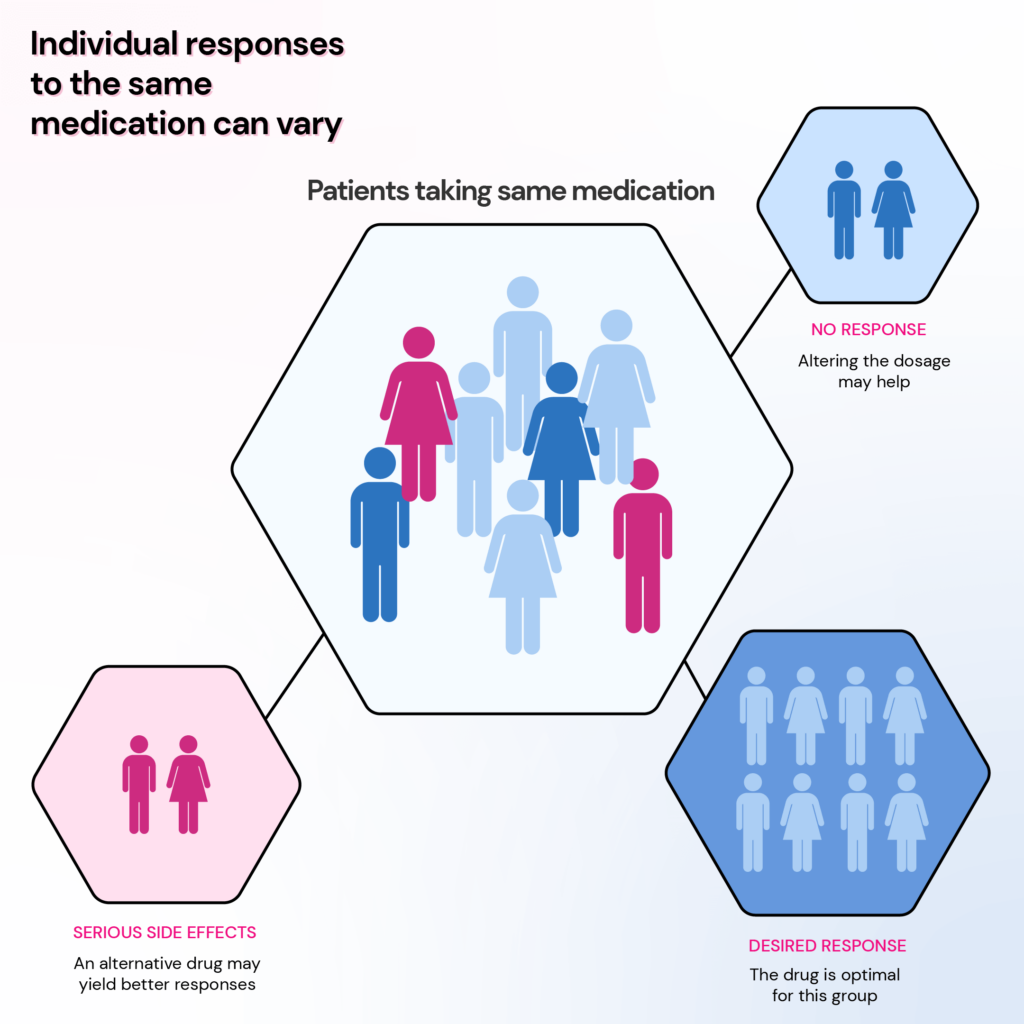
In some types of breast cancer, there are too many HER2 receptors.
Trastuzumab can treat only these types since it works by attaching to the HER2 receptors on cancer cells and killing them.
Abacavir is an effective treatment for AIDS since it fights against HIV.
Research suggests that about 5-8% of the people undergoing this treatment experience a hypersensitivity reaction, which manifests as rash, fatigue, and diarrhea.
This is due to an exaggerated response to the drug by the immune system.
Studies that explored the association between genes that regulate the immune system and abacavir hypersensitivity have discovered that a type of HLA gene called HLA-B*5701 increases the risk of hypersensitive reactions.
Those carrying this gene may benefit better from alternative drugs.
Statins are a class of drugs that lower blood cholesterol levels.
Certain transporter proteins made by the SLCO1B1 gene carry statins to the liver, where they function to remove excess cholesterol.
People with a certain genetic change in the SLCO1B1 (*5) may experience muscle problems like weakness and pain since this change results in lower levels of simvastatin taken to the liver.
Higher levels of statin in the muscles can cause statin-induced myopathy
Observational and patient registry studies report a 7% to 29% incidence of statin-associated muscle symptoms (SAMS).
The risk of SAMS in people carrying the *5 type of SCLO1B1 gene is the highest with simvastatin and the least with pravastatin or rosuvastatin.
Thus, pharmacogenetic testing for this gene allows tailoring statin therapy based on genetics.
Warfarin is a blood-thinning drug (anticoagulant) used to prevent heart attacks and strokes.
It works by interfering with the activity of an enzyme involved in blood clotting called the vitamin K epoxide reductase.
A gene called VKORC1 strongly influences warfarin dosing.
It produces vitamin K epoxide reductase, which is the target for warfarin.
People with a certain type of the VKORC1 gene have an increased sensitivity to warfarin and require a lower starting dose.
Certain enzymes in the CYP group, like CYP2C9, CYP3A4, and CYP1A2, play a role in warfarin pharmacogenomics.
Scientists are discovering that millions of people are living with an increased risk for certain serious health conditions without signs or symptoms due to small changes in their DNA.
Thanks to genomic medicine, it is possible not just to identify these variants but also to predict their effect to prevent these conditions years before symptoms appear.
Many common conditions are typically not caused by just a single mutation.
The risk is due to millions of inherited variants called SNPs, each of which contributes only a little to the disease risk.
But when we add the effect of these small changes, it can greatly impact an individual’s health profile.
Polygenic risk scores (PRS) are promising tools for predicting disease risk.
PRS calculates the sum of the effects of different variants to come up with a score that indicates a person’s risk for a particular health condition.
This information can allow physicians to devise effective preventive strategies and closely monitor high-risk individuals for early diagnosis.
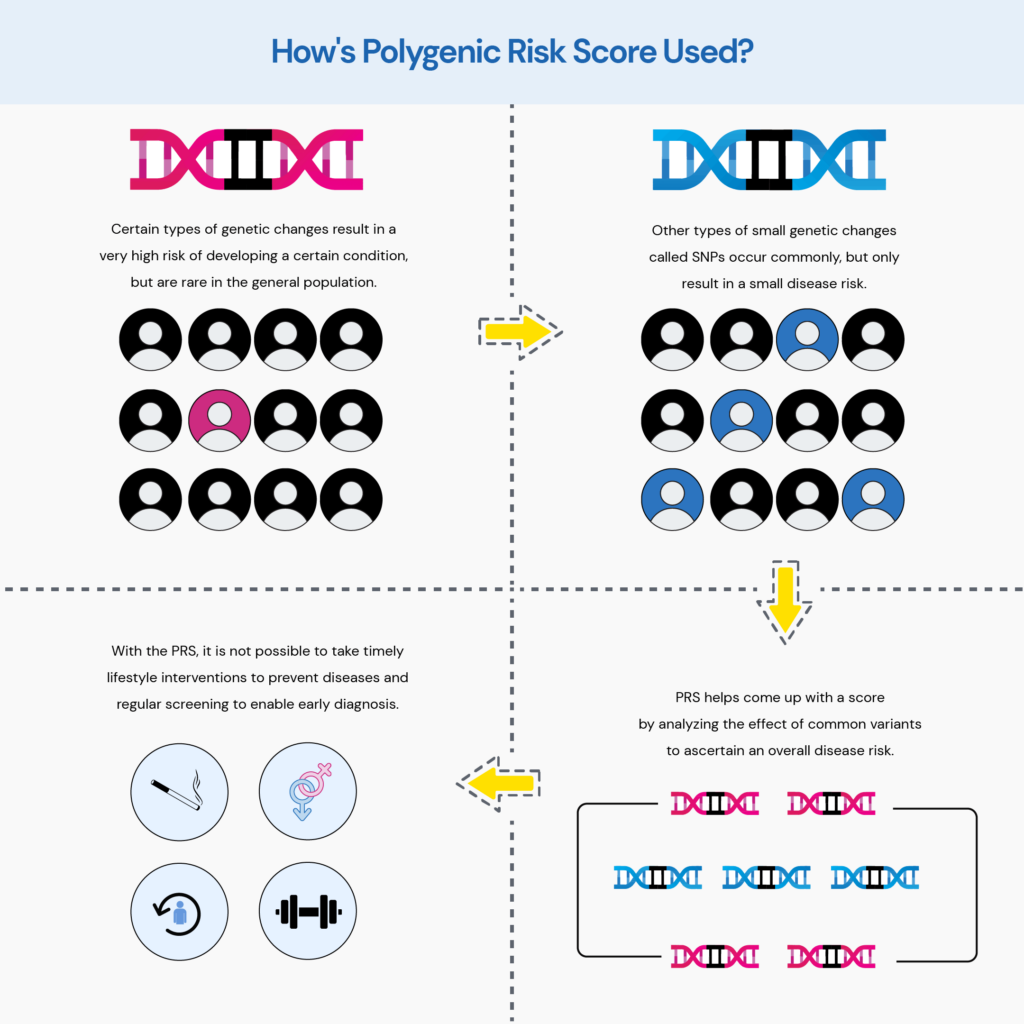
Gene Health Report: Identify your risk for 47 chronic diseases for just $50
It is safe to say that genomics is changing how doctors practice medicine and treat diseases.
According to a new white paper by BIS Research titled The Five Forces of Genomic Medicine, “genomic medicine has the potential to save lives, transform medical practice around the world, and drive billions of dollars of economic activity.”
The National Human Genome Research Institute (NHGRI) developed strategic engagement to identify future research priorities and opportunities in human genomics, emphasizing health applications in 2020.
Here is a summary of 10 bold and fantastical predictions made by experts at the NHGRI for the next decade.
| 10 Predictions About The Future Of Genomics By The NHGRI |
| Whole genome sequencing and analysis will become a normal routine in any research lab. |
| The function of every gene in human DNA will be discovered and understood. |
| The effects of the environment on gene function will be routinely taken into account to predict disease risk and health outcomes. |
| Studies will abandon race and other social constructs as biological categories in genomic research. |
| Students will regularly display projects regarding genome sequence studies as a part of their school science fairs. |
| Genetic testing will soon become a commonly used medical tool like blood tests. |
| Geneticists will readily be able to tell whether a variant is clinically relevant. |
| Each individual’s whole genome sequence will be accessible via smartphones in a user-friendly format. |
| Genomic advances will benefit not just certain people or communities but society as a whole. |
| Discoveries and new technologies in genomics will help cure many more genetic diseases. |
Pharmacogenomics in Psychiatry: Genetic testing can help identify individuals who may have a poor response or heightened risk of adverse reactions to certain psychiatric medications, such as antidepressants and antipsychotics. This information can guide clinicians in selecting the most effective medication and dose for each patient, improving treatment outcomes, and minimizing side effects.
Digital Health Technologies: Integrating genomic information with digital health technologies opens new avenues for personalized healthcare. Genomic data can be combined with wearable devices, smartphone apps, and telemedicine platforms to provide real-time monitoring, proactive health management, and personalized interventions. For example, genetic information can be used to create personalized exercise and nutrition plans tailored to an individual's genetic attributes and health goals.
Microbiome-based Therapies: The human microbiome, comprising trillions of microbes living in and on our bodies, significantly influences our health and disease susceptibility. Researchers are exploring the potential of microbiome-based therapies to treat various conditions, including gastrointestinal disorders, metabolic disorders, and even mental health disorders. By understanding the interplay between an individual's genetic makeup and their unique microbiome composition, personalized microbiome interventions can be developed to restore a healthy microbial balance and promote overall well-being.
The average lifespan of the human population is increasing.
According to the World Health Organization, life expectancy has increased globally by more than 6 years between 2000 and 2019 – from 66.8 years in 2000 to 73.4 years in 2019.
In this landscape, genomic medicine will transform healthcare to increase this number further.
Having genomic information at hand means having information about your health and well-being and the ability to make informed choices.
On the personal economy side, the resulting longer health span can increase a person’s earning capacity.
Further, with improved disease risk identification tools, individuals reduce their health costs through early detection and avoiding unnecessary treatments.
Genomic information can also help impact the national economy by cutting productivity loss and disease treatment costs.
With the continually declining costs of whole genome sequencing and swift results, the number of people who opt to get this done is on the up and above.
While opting for genome sequencing is a very personal choice, it could be worthwhile to be aware of its concerns.
The bottom line, genomic medicine can transform medicine and healthcare.
The medical and scientific communities worldwide are just beginning to seize the transformative opportunities.
We have just scratched the surface of genomic medicine, and a mountain of information is waiting to be discovered.
Have you ever wondered why some people can eat a lot without gaining weight while others struggle to lose weight even when they count every calorie? The answer partly lies in how our genes interact with the nutrients in our diet. Some people are genetically wired to be more efficient at breaking down fats and carbs than others. A DNA diet test can provide valuable insights into our genetic makeup and how it relates to our diet and nutrition. Beyond weight loss insights, it can reveal vitamin deficiencies that cause fatigue and muscle cramps, as well as food intolerances that lead to bloating and digestive issues. In this article, we will explore what DNA diet testing is, how it works, what it can and cannot do, and where to get it.
Did You Know?
A DNA diet test can provide insights into many aspects, from lactose intolerance and gluten sensitivity to vitamin, mineral, & macro needs. Our users experience significant improvement in their diet after taking this report. You can your existing ancestry test DNA data to access these insights and much more!
Learn How.
Our DNA contains the genetic code that influences our health and nutritional needs.
Genetic testing can reveal insights about an individual's unique traits and predispositions.
This information can provide personalized dietary and lifestyle recommendations customized to an individual's genetic profile.
Some genetic variants may increase susceptibility to certain conditions, so knowing one's genetic makeup can help guide preventative measures and targeted nutrition.
Overall, analysis of DNA gives people more knowledge about how their genes impact their well-being and responses to different foods and lifestyles.
DNA diet testing involves analyzing a person's DNA for genetic variants affecting nutrient digestion, athletic performance, exercise response, and overall well-being.
These genetic variants are called single nucleotide polymorphisms (SNPs).
SNPs are places in the genetic sequence where a single letter of DNA differs between individuals.
We all have millions of SNPs that make each person's DNA one-of-a-kind. Most SNPs have no effect, but some can impact essential processes in the body.
For example, certain SNPs affect how a person digests or transports vital nutrients like vitamin B12, fat, and caffeine.
Other SNPs influence factors like muscle-building capacity, endurance, ability to burn calories, or tendency to store fat.
Testing also looks for SNPs tied to risks for certain health conditions.
Kimberlee Says
I had my DNA results from Ancestry and was able to upload them to XCode and get answers to so many of my gene questions. Super quick turn around - I felt I needed to get answers to my breast cancer possibilities. XCode gave me answers in ~12 hours... Read More.
Many DNA testing companies offer different DNA tests, but some stand out for their quality, accuracy, and features.
Xcode Life analyzes your DNA raw data from any ancestry test and gives insights into your nutrition, mental health, fitness, skin, allergies, methylation, MTHFR, and more.
You can upload your whole genome sequencing data, get access to over 1500+ genetic traits, and join the satisfaction of over 150,000+ happy customers.
To meet your diverse needs and budgets, we offer customized super saver packs, such as:
Each pack provides personalized insights and recommendations aligned with your specific requirements and budget.
Other DNA testing companies you may have heard of are:
These companies focus on specific areas of your health and wellness, such as diet, sports performance, personality, or beauty.
Choose the best DNA testing company based on your goals and interests and discover how your genes affect your life.
DNA diet testing offers several advantages in enabling personalized dietary and lifestyle choices for optimal health and wellness:
The DNA diet testing process involves several key steps that transform genetic information into practical insights:
Step 1: DNA collection
The first step is to collect a DNA sample from the individual through a simple cheek swab or saliva sample. This is then sent to a laboratory.
Step 2: DNA extraction and purification
The lab receives the sample and extracts the DNA, purifying it to isolate high-quality genetic material for analysis.
Step 3: DNA amplification
The extracted DNA is amplified using polymerase chain reaction (PCR) to generate many copies of specific DNA segments for deep analysis.
Step 4: DNA sequencing
The amplified DNA is then sequenced to determine the order of nucleotides (A, T, C, and G) in the individual's unique genetic code.
Step 5: Genetic analysis and interpretation
The sequenced DNA is analyzed and compared to a database of known genetic variants related to diet, nutrition, sensitivities, and weight. The analysis is carefully interpreted to identify key genetic factors influencing the individual's dietary needs and weight management.
Step 7: Personalized insights and recommendations
Based on the genetic analysis, personalized diet and lifestyle recommendations are customized to the individual's genetic makeup to optimize health and wellness.
DNA diet testing should not be seen as a one-time event. Ongoing guidance from a healthcare professional is crucial for interpreting test results, making informed dietary decisions, and monitoring progress.
Let's delve into Linda's journey with nutrigenomic assessment. Linda, in her early 30s, was the epitome of what we might consider active and health-conscious. Daily jogs at dawn, yoga sessions, and a diet teeming with what the latest health blogs touted as 'superfoods' were all part of her routine.
Despite her dedication to maintaining what she believed was an optimal lifestyle, Linda often felt at odds with her own body – battling unexplained fatigue, bouts of random muscle cramps, troubling gut, and a persistent sense of not being at her peak.
After countless generic health check-ups and dietary tweaks that bore no significant results, Linda's quest for answers made her take a “DNA diet test.”
When the results came back, they painted a vivid picture of her body's unique nutritional needs and its potential pitfalls.
Among the revelations, a significant one stood out. Linda possessed a genetic variant that dramatically increased her risk of magnesium deficiency.
She took this report to her doctor, who correlated her results with the symptoms that had been clouding her day-to-day vitality. Low magnesium levels, the doctor explained, could be contributing to her muscle cramps and fatigue, as this micronutrient is pivotal for muscle and nerve function, as well as energy production.
The doctor recommended a course of high-quality magnesium supplements and advised incorporating magnesium-rich foods into her diet—dark leafy greens, nuts, seeds, and whole grains were to become her new staples.
Linda’s results also revealed that she carried a mutation that made her lactose intolerant. Although she occasionally consumed dairy with no immediate adverse effects, she sometimes experienced bloating and discomfort without making the connection to her dairy intake. Her doctor suggested incorporating lactose-free alternatives such as almond milk, coconut yogurt, and hard cheeses that are naturally lower in lactose.
Empowered with this personalized dietary blueprint, Linda embraced her new regime. Over the following weeks, she noticed a tangible uplift in her well-being. The fatigue that once loomed over her mornings began to lift, and the random cramps that had interrupted her yoga flows became infrequent guests rather than persistent intruders. Her gut never felt better!
The changes didn't stop there. The insights from the nutrigenomic assessment enabled her to understand her predisposition to other conditions, nudging her to make preventative lifestyle adjustments.
Gene Nutrition Report: 48 unique dietary insights for just $40
While DNA diet tests can provide valuable insights into your genetic makeup and its impact on health and wellness, it's crucial to recognize their limitations.
These tests cannot:
The cost of a DNA diet test can vary depending on the provider, test type, and desired level of detail.
Prices can vary from $49 to over $999, considering additional expenses like shipping fees, lab charges, and optional services such as consultations or detailed reports.
At Xcode Life, affordable and personalized genetic insights are essential. Our range of targeted DNA tests, starting at just $30, covers various aspects of health and wellness, including diet, fitness, and disease risk.
Note: Prices are subject to change, so it is advisable to verify the current cost directly with the provider to ensure you have the most recent and accurate information.
A DNA diet test is an innovative method that analyzes an individual's genetic makeup to personalize nutrition and health choices.
This process identifies single nucleotide polymorphisms (SNPs) influencing nutrient processing, exercise response, and health risks.
Leading companies like Xcode Life offer comprehensive DNA testing services, allowing individuals to understand various aspects of their genetic traits.
The benefits include personalized insights into nutrient digestion, athletic performance, exercise response, and overall health and wellness.
The testing process involves DNA collection, extraction, amplification, sequencing, genetic analysis, and interpretation, leading to personalized recommendations.
However, it's essential to recognize the limitations of DNA diet tests, as they cannot provide a cure-all solution or guarantee long-term effectiveness.
The cost of a DNA diet test varies but can start at $30, with prices subject to change.
While these tests offer valuable information, ongoing guidance from healthcare professionals is crucial for interpreting results and making informed decisions.
https://www.ncbi.nlm.nih.gov/pmc/articles/PMC2906751/
https://www.cdc.gov/ncbddd/folicacid/mthfr-gene-and-folic-acid.html
https://medlineplus.gov/genetics/gene/apoe/
https://medlineplus.gov/genetics/condition/lactose-intolerance
In a world where genetic testing is increasingly becoming a crucial tool for understanding health risks and conditions, Ambry Genetics emerges as a significant player in this field. Established in 1999, the company specializes in a range of genetic tests, from hereditary cancer to neurological conditions. This review aims to provide an unbiased overview of Ambry Genetics, exploring its services, processes, and policies. We will look at how it conducts genetic testing, the types of tests offered, the ordering process, and its approach to privacy and pricing, helping you make an informed decision about using its services.
Did You Know?
The DNA data from your genetic ancestry test can be used to learn important things about your health, from your risk for heart disease and stroke to food intolerances and sleep disorders. You can upload your DNA data to learn 1,500+ things about your health. Learn more.
Ambry Genetics, founded in 1999 by Charles Dunlop, is a genetic testing and diagnostic company. Currently led by Dr. Aaron Elliot, as a part of Konica Minolta Precision Medicine, Ambry has its headquarters in Aliso Viejo, CA, USA. Its labs are CLIA/CAP-certified.
Ambry was the first lab to offer BRCA testing and complete gene sequencing services since 2001. With its CLIA/CAP-certified SuperLab, Ambry currently provides the following genetic tests:
Ambry offers services only for patients residing in the United States.
It does not sell test kits directly to consumers to provide raw DNA data.
So, to avail of genetic testing services with Ambry Genetics, you need to contact a healthcare provider first.
Ambry Genetics offers free genetic counseling for people who test positive for a clinically significant mutation associated with cancer.
The company also provides other counseling aids and tools on its website to help explain the test results.
Apart from these, Ambry also offers an added-on RNA testing feature, which provides more accurate and actionable results than DNA testing alone.
RNA is a molecule similar to DNA but single-stranded. RNA is directly involved in protein production.
The first stop to avail this service is a healthcare practitioner. Once they determine that you are at risk for a particular genetic condition, they will recommend an appropriate test.
About 10% of cancer cases are hereditary, and the mutation(s) contributing to cancer can be traced through genetic testing.
If you have a strong family history of cancer, your doctor may recommend this panel for you.
This panel tests for the following types of cancer:
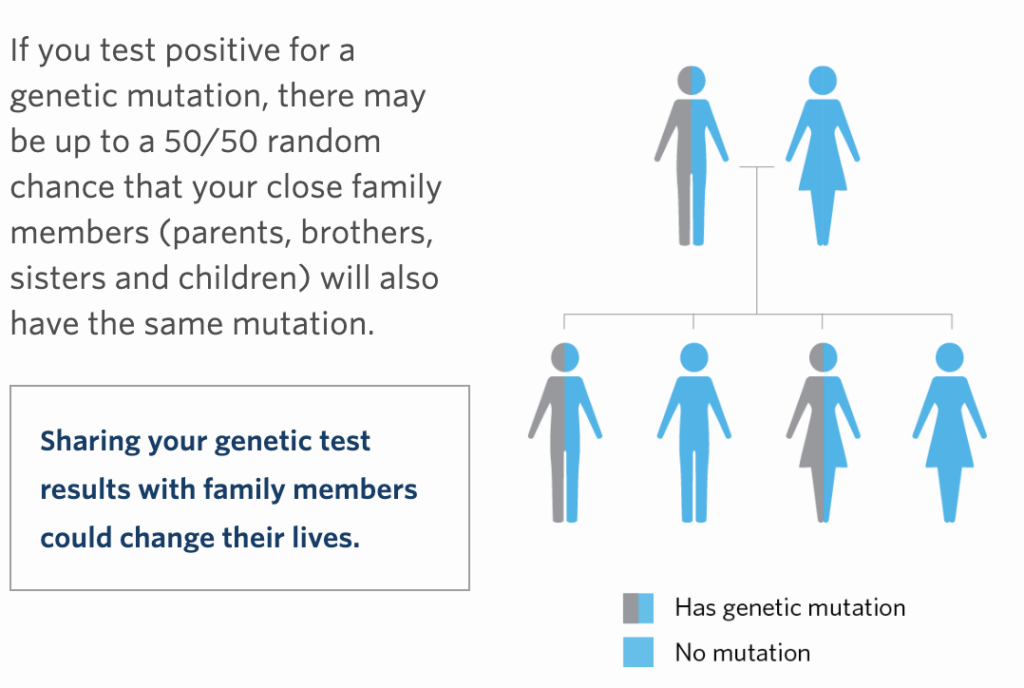
The term heart disease encompasses several conditions that affect heart health. Out of this, some are caused due to genetic mutations and, thus, can be inherited.
Your doctor may recommend this panel if you or your family members have been diagnosed with a heart disorder, high cholesterol levels, a history of fainting or passing out, or had unexplained cardiac arrests.
The panel tests for the following conditions:
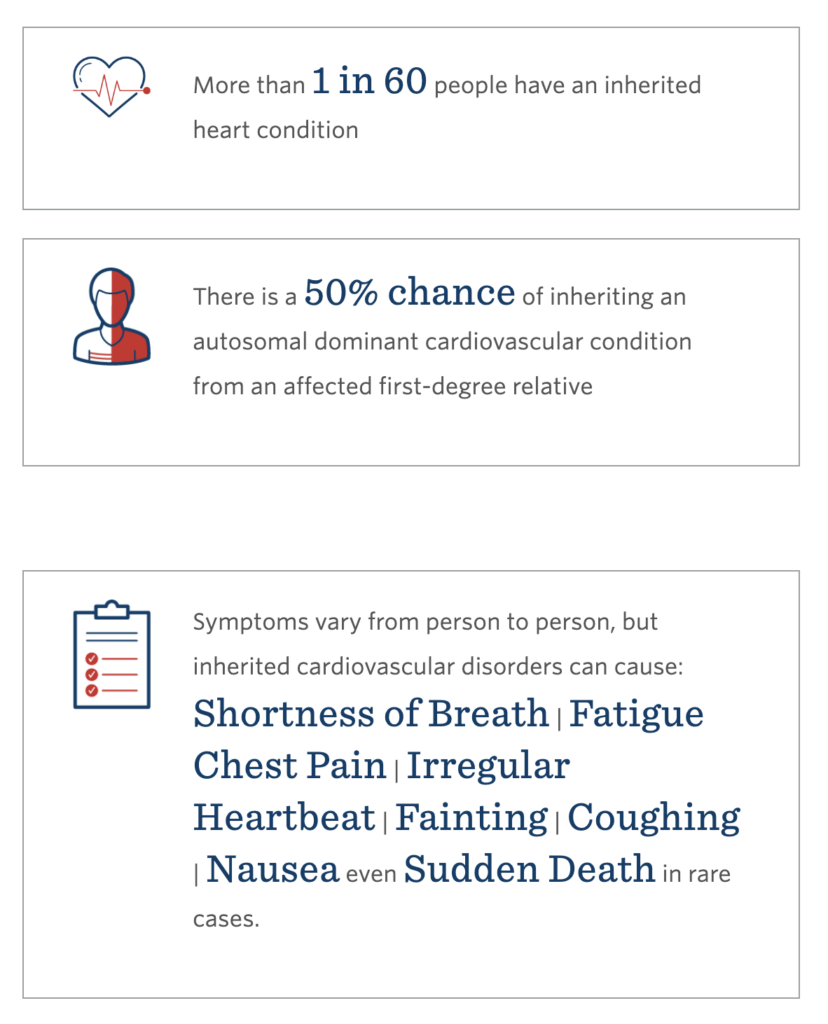
Any condition affecting the brain or spinal cord falls under neurological diseases.
While many factors like infections, poor nutrition, and exposure to heavy metals can cause neurological disorders, carrying a genetic change can make you more prone to them right from birth.
The following tests are available in the neurological panel:
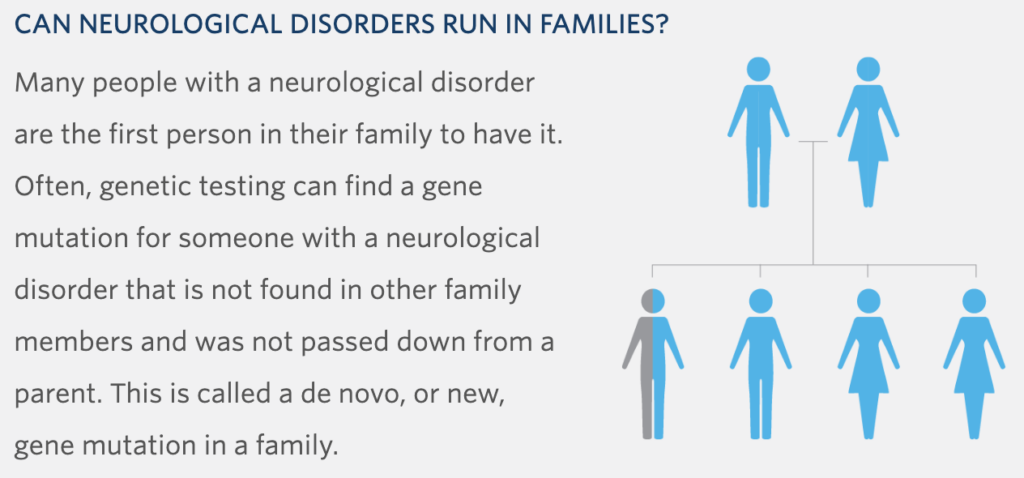
A baby can be born with a genetic disease caused due to a mutation either by chance or because the parents may be carriers of a particular condition.
With prenatal screenings, it is possible to detect the mutation (if present) in the baby during pregnancy itself.
Ambry Genetics offers two tests in this panel.
Carrier Screening
This is done for the biological parents (potential) and is available even during pregnancy.
It tests for conditions like cystic fibrosis, spinal muscular atrophy, etc.
Non-Invasive Prenatal Testing (NIPT)
NIPT is done by isolating fetal DNA from maternal blood.
It tests for chromosomal conditions like trisomies (13, 18, and 21) and other aneuploidies.
In this panel, Ambry offers two types of tests to detect mutations underlying rare genetic conditions.
This test is useful if previous genetic tests haven't yielded useful results or if there's no specific test available for a given condition.
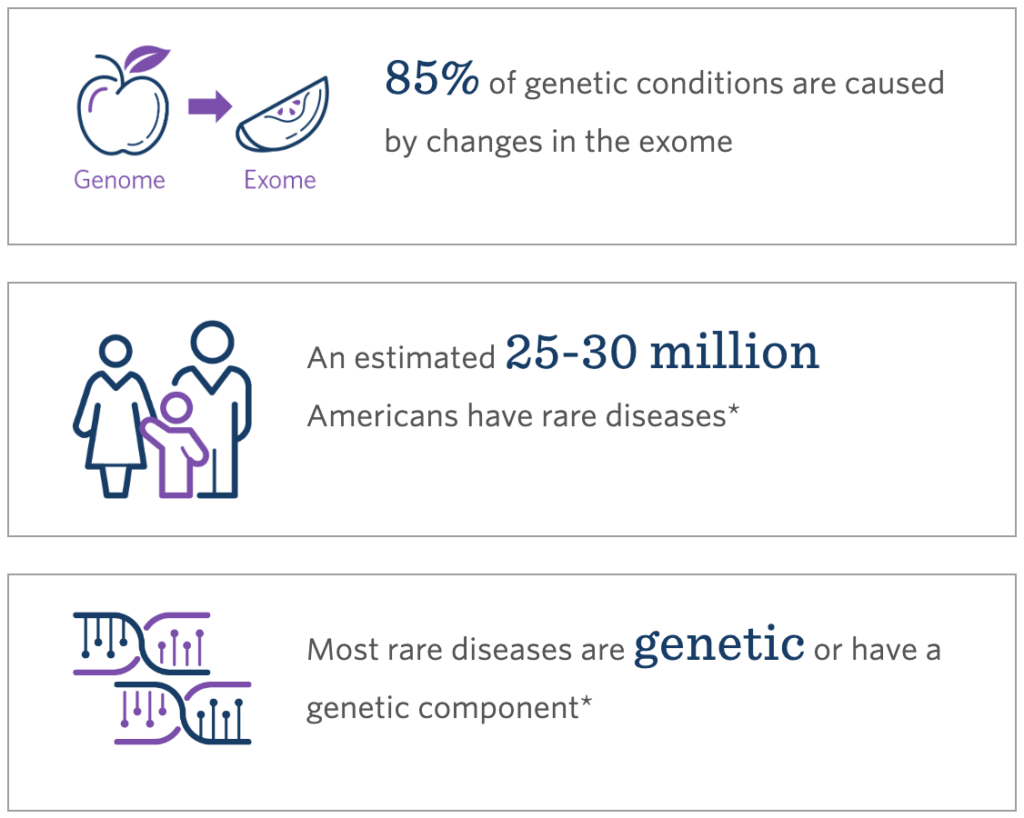
Ambry Genetics presents its services for healthcare professionals through a separate portal with login services.
They emphasize their focus on patient-centric testing, supported by rigorous scientific processes and a team of experts, including genetic counselors.
Ambry offers a broad spectrum of genetic tests in areas like oncology, neurology, and cardiology, accompanied by an easy-to-use online ordering system and telemedicine support.
The company also stresses its commitment to gender inclusivity and provides various resources, including clinical materials and educational webinars, to assist healthcare providers in making informed decisions for their patient's care.
Ambry Genetics requires you to take the test through a healthcare provider.

You will then need to provide a sample depending on your test type. There are a few ways to submit your DNA sample for genetic testing.
You can check out the instructions for saliva sample collection here.
Once you collect your sample and send it to Ambry, the lab will run the genetic tests and provide the results to your healthcare provider, who can access it via their login.
Ambry uses Clinical Diagnostic sequencing as a discovery tool. It helps improve patient diagnosis and also enables affordable large-scale genetic testing.
Ambry uses quality lab processes, confirmatory testing, and advanced technology to ensure that the results are as informative and accurate as possible.
The team of scientists uses peer-reviewed publications to compile supplementary information for the genetic testing reports.
The genetic testing reports may differ from one test to another, but all reports include the following:
The result table displays the following:
The interpretation provides a detailed explanation of the results, discussing risk factors and diagnosis. It also includes information on the genes and their variants.
The summary tells you if you have tested positive or negative for the mutation(s) associated with the condition(s) tested.
This section outlines the genetic testing procedure and provides information on the processing of your DNA sample.
Reports also contain supplemental information with report references. Additionally, it includes an interspecies comparison with a detailed description of the variations.
The reports are tailor-made for use by genetic counselors and healthcare providers, including information vital for patient medical care.
If you have insurance coverage, the test can cost you anywhere from $0 - $100. According to the website, 4 out of 5 patients pay $0 for their tests.
However, if your insurance does not cover genetic testing, the test can cost $249.
The actual cost will ultimately depend on the type of test required.

Before allowing your healthcare provider to order a kit for you, it is essential to check the details of your health insurance plan.
Your health provider will then fill out an insurance pre-verification form to help Ambry estimate the out-of-pocket cost of your genetic testing.
The company provides free genetic testing to patients of select genetic diseases in collaboration with pharmaceutical partners.
Ambry Genetics claims to be committed to protecting user privacy. However, to access its services, you will have to accept the terms of its privacy policy.
Ambry’s privacy policy may change from time to time, with updates posted to the website.
Ambry keeps track of user activity and maintains visitor logs to put together anonymous aggregate statistics.
Ambry may collect, store, and use personal information when voluntarily submitted during registration. The company will use this information to contact its users and improve its services.
By accepting Ambry’s privacy terms, you give the company consent to share your information with third-party individuals like genetic counselors, healthcare providers, etc.
Ambry Genetics Review on Facebook (5/5 - based on 31 reviews)
Ambry Genetics on Google Reviews (3.7/5 - based on 15 reviews)
Upload the file to Xcode Life to get insights into 1000+ health-related traits at a 48% discount!
*screenshots taken from the Ambry Genetics website